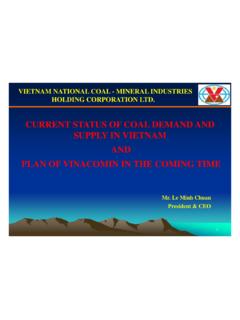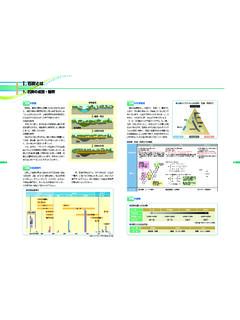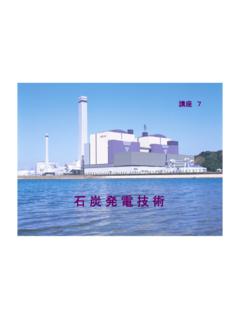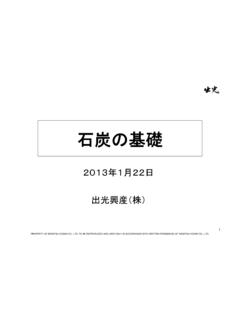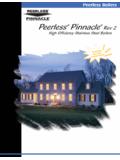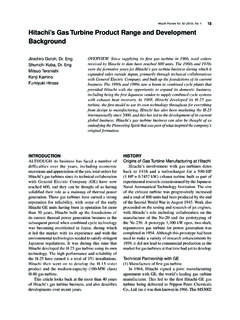Transcription of 2A2. Circulating Fluidized-bed Combustion …
1 Coal- fired Power generation Technologies ( Combustion Technologies)252A2. Circulating Fluidized-bed Combustion technology (CFBC) technology Overview 1. Features The features of Circulating Fluidized-bed boilers are ) Compatibility with wide range of fuelsConventional boilers for power generation can use only fossil fuels, such as high-grade coal, oil, and gas. The CFBC is also capable of using low-grade coal, biomass, sludge, waste plastics, and waste tires as ) Low pollutingNOx and SOx emissions are significantly decreased without special environmental modifications. In the case of Fluidized-bed boilers, desulfurization is carried out intrafurnace, using mainly limestone as the fluidizing material. For denitration, PC boilers operate at Combustion temperatures from 1,400oC to 1,500oC, whereas Circulating Fluidized-bed boilers operate at lower temperatures, ranging from 850oC to 900oC, thereby suppressing thermal NOx emissions as the generation of NOx is dependent upon the Combustion temperature.
2 In addition, the operation of Circulating Fluidized-bed boilers involves a two-stage Combustion process: the reducing Combustion at the Fluidized-bed section, and the oxidizing Combustion at the freeboard section. Next, the unburned carbon is collected by a high-temperature cyclone located at the boiler exit to recycle to the boiler, thus increasing the denitration ) High Combustion efficiencyImproved Combustion efficiency is attained through the use of a Circulating fluidization-mode Combustion ) Space-saving, ease of maintenanceSpace saving is attained because there is no need for separate desulfurization, denitration, and fine-fuel crushing units. Accordingly, trouble-spots are minimized, and maintenance is Study period Most of the Circulating , atmospheric-pressure Fluidized-bed boiler (CFBC) technologies were introduced into Japan from abroad, beginning around Progress and development results CFBC technology was introduced from abroad and used in coal- fired boilers.
3 It is used by power producers, iron makers, paper producers, and in other sectors. Plans exist to distribute CFBC technology to China under the Green Aid Plan (GAP). Outstanding CFBC-related issues include the further investigation of and efforts to reduce the initial costs and to improve the power generation efficiency for boilers using fuels such as RDF, industrial waste, and wood-based technology overview Figure 1 shows a typical CFBC process flow. Figure 2 provides a rough overview of CFBC. Generally, CFBC consists of a boiler and a high-temperature cyclone. The intra-furnace gas velocity is as high as 4 to 8 m/s. A coarse fluidizing medium and char in the flue gas are collected by the high-temperature cyclone and recycled to the boiler.
4 Recycling maintains the bed height and increases the denitration efficiency. To increase the thermal efficiency, a pre-heater for the fluidizing air and Combustion air, and a boiler feed water heater, are installed. Most of the boiler technologies are manufactured overseas, mainly from Foster Wheeler, Lurgi, Steinmuller, ALSTOM, and Babcock & 2 Schematic drawing of CFBC Fig. 1 Process flow of Circulating Fluidized-bed boiler3. Study site and application field Photo 1 shows an overview of a CFBC boiler facility. The CFBC gained popularity mainly as a coal- fired boiler. Recently, however, CFBC boilers using RDF and wood-based biomass as the fuel have drawn attention. Typical applications of coal- fired biogas are the Kuraray Co., Ltd. s Tamashima plant (70 t/hr), Idemitsu Kosan Co.
5 , Ltd. s Chiba oil refinery (300 t/hr), and Ube Industries, Ltd. s Isa plant (210 t/hr). An example of an RDF- fired boiler is Sanix Inc. s Tomakomai plant. The biomass fuel is mixed with coal and combusted, thereby decreasing CO2 steamCycloneCirculatingfluidized-bed furnaceBoiler feed waterID fanAsh storage tankStackFlue gasSecondary airPrimary airHeatrecoverysectionElectricprecipitat orLimestoneCoalCFBC boilerHot cycloneBoiler feed water heaterAir pre-heaterPhoto 1 CFBC appearancePart 2 CCT Overview

